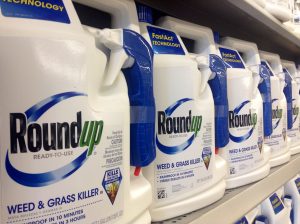10
Jul
California Lists Glyphosate as a Carcinogen but Controversy Remains
(Beyond Pesticides, July 10, 2017) The state of California has listed glyphosate, the active ingredient in the popular Roundup, as a known carcinogen under its Proposition 65 law. This listing went into effect July  7, 2017. Now, state officials have to develop guidelines for product labels and determine what level of exposure to the pesticide will put people at risk for developing cancer. Some have argued that the state’s proposed levels are not protective enough. Meanwhile, the state continues to face pressure from Monsanto, maker of glyphosate, which continues to challenge the decision to list the chemical as a known cancer-causing agent.
7, 2017. Now, state officials have to develop guidelines for product labels and determine what level of exposure to the pesticide will put people at risk for developing cancer. Some have argued that the state’s proposed levels are not protective enough. Meanwhile, the state continues to face pressure from Monsanto, maker of glyphosate, which continues to challenge the decision to list the chemical as a known cancer-causing agent.
California’s decision to list glyphosate as a carcinogen was prompted by the International Agency for Research on Cancer’s (IARC) finding in 2015 that it is a “probable” human carcinogen. This classification was based on sufficient evidence of carcinogenicity in experimental animals. Later that year, California Environmental Protection Agency’s Office of Environmental Health Hazard Assessment (OEHHA) announced that it intended to list glyphosate as a cancer-causing chemical under California’s Safe Drinking Water and Toxic Enforcement Act of 1986 (Proposition 65). Under California law, Proposition 65 requires that certain substances identified by IARC be listed as known cancer-causing chemicals. Glyphosate’s listing became effective July 7, 2017. Now, OEHHA has until early April 2018 to work out guidelines for glyphosate product warnings before requirements for such warnings take effect in July 2018.
The issue of contention for the state surrounds what level of exposure California might allow without any warnings. The state has proposed what some see as an overly generous ‘safe threshold’ or “No Significant Risk Level” (NSRL) for glyphosate at 1100 micrograms per day, meaning exposure levels and discharges into drinking water sources below that benchmark would be exempt from warning requirements. Setting the NSRL is done so that companies will be able to determine whether they need to provide warnings and/or reformulate products. Food products containing glyphosate residues that cause an exposure exceeding the final NSRL would be included in the warning requirement.
However, critics point out that the proposed NSRL is significantly higher than amounts that have been shown to have cancer-causing effects in several animal studies. A letter submitted to OEHHA from a group of scientists and advocates expressed concern that the proposed NSRL is not sufficiently health protective, and identified studies that show statistically significant increases in tumor incidence with oral administration of glyphosate at doses far below 1000 mg/kg/day. The letter urged OEHHA to lower the NSRL and uphold its statutory mission to protect humans from the harmful impacts of glyphosate.
In addition, allegations of possible OEHHA collusion with Monsanto over the setting of the NSRL have cast a dark cloud over the process. It was revealed in legal documents by lawyers for scores of cancer victims currently suing Monsanto over Roundup, that before California regulators set the NSRL they met privately with Monsanto in 2015 to discuss Monsanto’s recommendations for calculating the NSRL and which studies should be considered. Already, there is an investigation by the inspector general for the U.S. Environmental Protection Agency (EPA) into whether or not an EPA official engaged in collusion with Monsanto regarding the agency’s safety assessment of glyphosate.
Monsanto is still challenging the listing of glyphosate under Prop 65. Its lawsuit against OEHHA was dismissed by a Fresno County Superior Court judge in March, but Monsanto appealed the dismissal and that appeal is still pending. The company’s effort to block the listing while the appeal is pending failed. As recently as June 20, Monsanto was continuing to press OEHHA to drop or delay the glyphosate listing, arguing that the IARC classification was invalid.
As evidence of the hazardous effects of glyphosate continues to mount, environmental groups like Beyond Pesticides are urging localities to ban or restrict the use of the chemical and other toxic synthetic pesticides. These groups maintain that California’s glyphosate listing is certainly a step in the right direction; however, further steps toward a restriction or ban will be needed to protect the public’s health. Being the number one agricultural producing state, California’s action may help to move glyphosate off the market, which would serve as a victory for the low-income communities in the southern part of the Central Valley that are exposed to glyphosate at higher levels than the general population.
The best way to avoid glyphosate and other harmful pesticides is to support organic practices in landscapes and agriculture and purchase organic food. Beyond Pesticides has long advocated for organic management practices as a means to foster biodiversity, and research shows that organic land management does a better job of protecting biodiversity than its chemical-intensive counterparts. Instead of prophylactic use of pesticides and crops bioengineered with insecticides, responsible organic practices focus on fostering habitat for pest predators and ecological balance, and only resort to judicious use of least-toxic pesticides when other cultural, structural, mechanical, and biological controls have been attempted and proven ineffective.
All unattributed positions and opinions in this piece are those of Beyond Pesticides
Source: Environmental Health News










